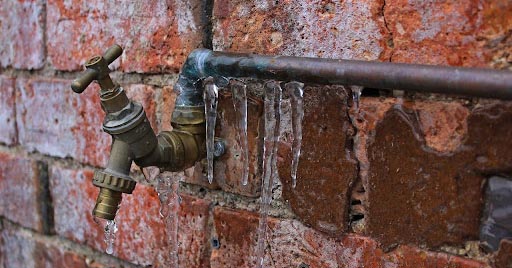What To Do If Your Pipes Freeze


Frozen pipes are more than a headache. They're a costly situation. In fact, each pipe can cost about $150 to $250 per linear foot for a professional to replace. If your pipes have a lot of damage or you need underground pipes replaced, you could be looking at $5,000 or more. None of these numbers consider the additional costs of property damage and lost belongings.
The high costs of frozen pipes also lead to many insurance claims. According to State Farm, the insurance company paid $181 million in 2022 alone for homeowner claims relating to frozen pipes.
Whether you're in a northern region where frozen pipes are common or a southern region where the occasional storm can cause damage, frozen pipes are an unexpected expense you don't want to have. To save money, it's best to take immediate action if you think water froze inside your home's plumbing. Here are helpful tips on how to unfreeze pipes.
If your region recently experienced below-freezing temperatures, your pipes might have frozen. How do you spot a frozen pipe? Look for these signs:
Every house has cold water and hot water pipes. Usually, these pipes run inside your home. However, some homes—especially older homes—have pipes that run along exterior walls. You're more likely to get a frozen pipe if it is outdoors or goes through an unheated part of the home and lacks proper insulation.
Can hot water pipes freeze? Yes. These pipes also tend to experience higher pressure between the hot water and the water that's turning into ice. Whether it carries hot or cold water, though, any pipe can freeze if the water temperature drops below a specific number. For exposed or exterior pipes, 32 degrees Fahrenheit is the limit. For most indoor pipes, it's around 20 degrees Fahrenheit.
Do hot water pipes freeze first? In many cases, yes. According to the Mpemba effect, heated water loses energy quicker than cold water and freezes faster. So, hot water pipes in your home could freeze faster than cold water pipes if not properly insulated.
You've found a frozen pipe. The first step is shutting off the water to the house using the main shut-off valve. You don't want water to leak out when the ice thaws because this can cause excessive damage and costly repairs. If you can't find the main shut-off valve, turn off the water around the frozen pipe and try to locate the main valve as soon as possible.
Most shut-off valves in single-family homes are found outdoors in a box or in the basement or crawlspace where water enters the home. You’ll often need a wrench or water key to move the lever.
Condos and apartments are a bit different. There may be a shut-off valve for each unit, or it may be one valve for each building. Check with your building manager to see whether you can shut off the water yourself or who to call if you need it shut off. That way, if a frozen pipe occurs, you can shut off your water as quickly as possible.
Next, search for other sections of the pipe that may have frozen. Is your outdoor faucet frozen, too? Check outside for visible plumbing because there could be more than one area with ice blocking the water supply. After you find all the problem areas, open the nearest faucets. This helps relieve the intense pressure building up inside the pipe.
The next step is to melt the ice. Consider one of the following:
For hair dryers and space heaters, aim the heat at the frozen pipe, but don't let the two make contact. You can wrap hot towels, heat tape, or a heating pad around the pipe because the heat is more dispersed. Avoid using anything with an open flame, such as blowtorches, propane, or kerosene heaters. You also want to stay safe when using electric heating products near water, so pay attention to where the melting ice pools.
Keep heating the pipe until the ice melts and water flows freely. If you discover any cracks at this point, it's best to call a plumber right away.
The biggest dangers of a frozen pipe happen after a pipe bursts. Water gushing out of a pipe can quickly lead to flooding and significant property damage. Not only can you lose valuables and other family mementos, but there's an increased risk of drowning, especially in basements.
Frozen pipes also lead to added expenses. When you factor in the costs of repairing the pipe, clearing the flood waters, disposing of destroyed belongings, and repairing structural damage, you'll find that the financial burden of a burst pipe feels neverending.
Now that you know what to do if your pipes freeze, can you take other preventive steps? You can insulate your pipes, winterize outdoor faucets, and seal any gaps in your home. You can also get peace of mind with a home warranty.
You can't prevent Mother Nature's inclement weather, but you can lessen the financial and sentimental losses when prepared. Contact AFC Home Warranty today to learn how our home warranty plans can help you save money on costly repairs.

Coverage not available in CA, WA and HI